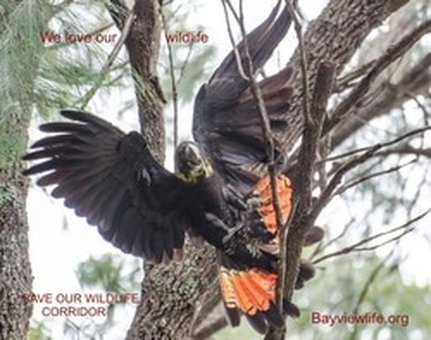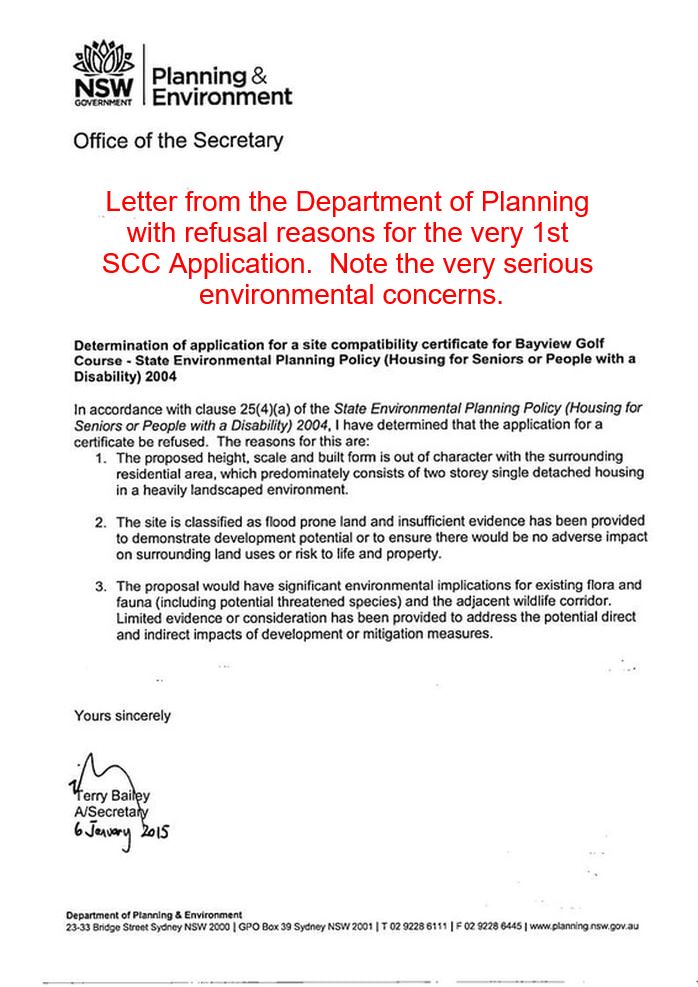
In 2016 The Department of Planning (DPIE) refused an SCC application based on environmental and flooding risks.
But in 2017 the DPIE issued a Site Compatibility Certificate (SCC) to permit a DA to be submitted for a very large Seniors Development in the middle of this wildlife corridor.
This allowed a DA proposal to proceed which will destroy a total of 252 trees (as shown in part in the photo above) to make way for 5 ACRES, of 7 Buildings, with 85 units,
3 storeys high on "OPEN SPACE" , recreational, wildlife habitat, biodiversity land on the Bayview Golf course.
A first SCC application was submitted in 2015
This first SCC was refused by the DPIE in 2016
A second SCC application was submitted in 2016
The second SCC was approved by the DPIE in 2017
A subsequent DA was lodged with Council in December 2017
The DA was recommended for refusal by Council in August 2018
The DA was refused by the Planning Panel in August 2018
Amended DA plans have been lodged in September 2018
An Appeal in the LEC was lodged in September 2018
The DA plans were refused by the Commissioner of the LEC in March 2019
The 2nd SCC expired in March 2019
THE ORIGINAL DA WAS REFUSED
on 13 August 2018 by the
Sydney North Planning Panel
The modified DA was refused by the LEC in March 2019
BUT the Developer is now trying again despite this resounding refusal,
despite overwhelming community objections to this development.
(78,000 people have signed our petition)
Similar plans to those refused by the LEC have been submitted now to the DPIE as part of an application for a new SCC.
252 trees will still be removed,
which will destroy the wildlife corridor and existing wildlife habitat.
It takes 25 to 50 years to regrow these remnant and important trees !
The total number of trees may be much more due to required bushfire APZ clearance zones and the effects of deep excavation on tree roots.
Click here read the PLANNING PANEL'S REFUSAL REASONS
The Microbat colonies saved. The family of Powerful Owls saved. The Bent Wing Bat saved,
The glossy black cockatoos saved.
If these amended plans ever get approved then all their wildlife habitat would go.
The building work, the apartment lights & residential noise would chase them away.
They would disappear and not return, no matter how many seedlings they re-plant ! !
The replanting is planned from seeds and seedlings.
This is NOT a LIKE FOR LIKE BIODIVERSITY OFFSET !
These seedlings will take 25 to 50 years to grow into significant wildlife habitat.
Read this article in the SMH about 'Inappropriate SEPP Seniors Developments'
As Rob Stokes said, he held environmental concerns and constraints in respect of the future plans .
Mr Stokes said " it was not an appropriate place for multi-storey residential apartment buildings ".
The first Dept of Planning Site Compatibility Certificate (SCC) was knocked back on environmental concerns.
This DA was refused on many grounds including a number of Legal Grounds !
Mr Stokes should know as he is our NSW Planning Minister and he is an environmental lawyer.
The certificate should not be issued because of environmental issues.
WHY HAS THIS PROPOSAL REMAINED CURRENT IF THERE ARE LEGAL AND ENVIRONMENTAL ISSUES?
--------------------------------------------------------------------------------------------------------------
VIEW OUR PETITION HERE:
Ban new development in Sydney's Wildlife Corridors
Watch a video below explaining how sensitive powerful owls are to destruction of their habitat. This video explains clearly why you need 100 to 150 year old trees for these vulnerable species and why new little saplings just won't do!
Click here to watch the video about Powerful Owls.
Click here to watch the video about Powerful Owls.
Habitat protection was the main focus of
Treatened Species Recovery 9 July 2015
A report released by
BirdLife Australia, the Australian Conservation Foundation and Environmental Justice Australia
reported that recovery plans designed to prevent Australia’s most endangered species from extinction are failing to protect habitat.
The report, Recovery Planning — Restoring Life to our Threatened Species, reveals that of Australia’s 120 most endangered animals, only 10 per cent had plans that placed any clear limits on the future loss of habitat.
“Threatened Species Recovery Plans, developed under the EPBC Act, are the Federal Government’s key instrument for bringing threatened species back from the brink of extinction,” said James Trezise, a Policy Coordinator for the Australian Conservation Foundation.
“While these Recovery Plans help bring together the data and science needed to recover threatened species — our analysis shows that they are currently failing in the vital task of protecting habitat.”
“Habitat destruction is one of the major drivers for threatened species decline,” he said. “The analysis in this report shows that current recovery plans consistently avoid prescriptive measures to protect threatened species’ habitat.”
The report makes a series of recommendation including ways to improve recovery planning.
“Extinction is a choice,” said Samantha Vine, Head of Conservation at BirdLife Australia. “Where we have tried in the past, Australia has been remarkably successful at recovering threatened species.”
“In many cases, averting extinction has been straightforward and relatively inexpensive.”
“Securing and improving existing habitats for threatened species remains one of the most powerful and cost effective conservation tools at our disposal,” Samantha added. “It is essential that Australia makes protecting endangered species’ habitat a key focus in combating the current extinction crisis.”.
Treatened Species Recovery 9 July 2015
A report released by
BirdLife Australia, the Australian Conservation Foundation and Environmental Justice Australia
reported that recovery plans designed to prevent Australia’s most endangered species from extinction are failing to protect habitat.
The report, Recovery Planning — Restoring Life to our Threatened Species, reveals that of Australia’s 120 most endangered animals, only 10 per cent had plans that placed any clear limits on the future loss of habitat.
“Threatened Species Recovery Plans, developed under the EPBC Act, are the Federal Government’s key instrument for bringing threatened species back from the brink of extinction,” said James Trezise, a Policy Coordinator for the Australian Conservation Foundation.
“While these Recovery Plans help bring together the data and science needed to recover threatened species — our analysis shows that they are currently failing in the vital task of protecting habitat.”
“Habitat destruction is one of the major drivers for threatened species decline,” he said. “The analysis in this report shows that current recovery plans consistently avoid prescriptive measures to protect threatened species’ habitat.”
The report makes a series of recommendation including ways to improve recovery planning.
“Extinction is a choice,” said Samantha Vine, Head of Conservation at BirdLife Australia. “Where we have tried in the past, Australia has been remarkably successful at recovering threatened species.”
“In many cases, averting extinction has been straightforward and relatively inexpensive.”
“Securing and improving existing habitats for threatened species remains one of the most powerful and cost effective conservation tools at our disposal,” Samantha added. “It is essential that Australia makes protecting endangered species’ habitat a key focus in combating the current extinction crisis.”.



